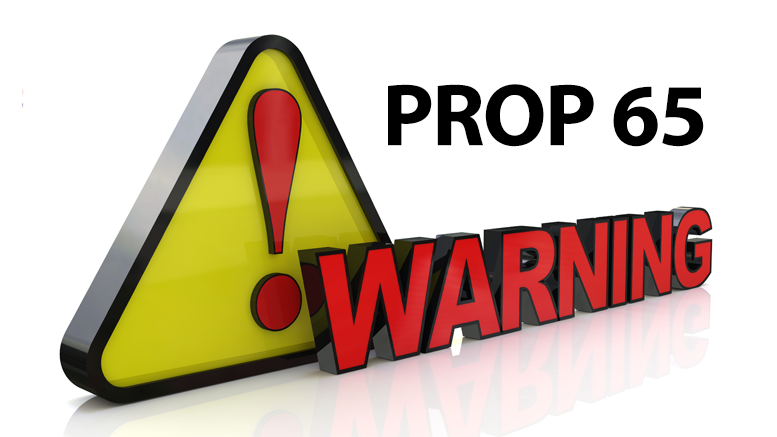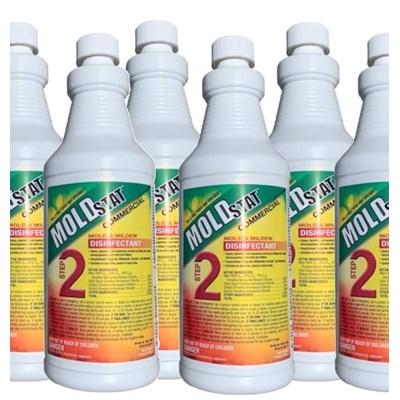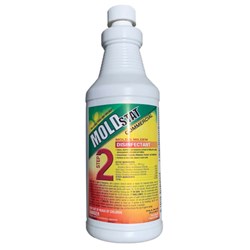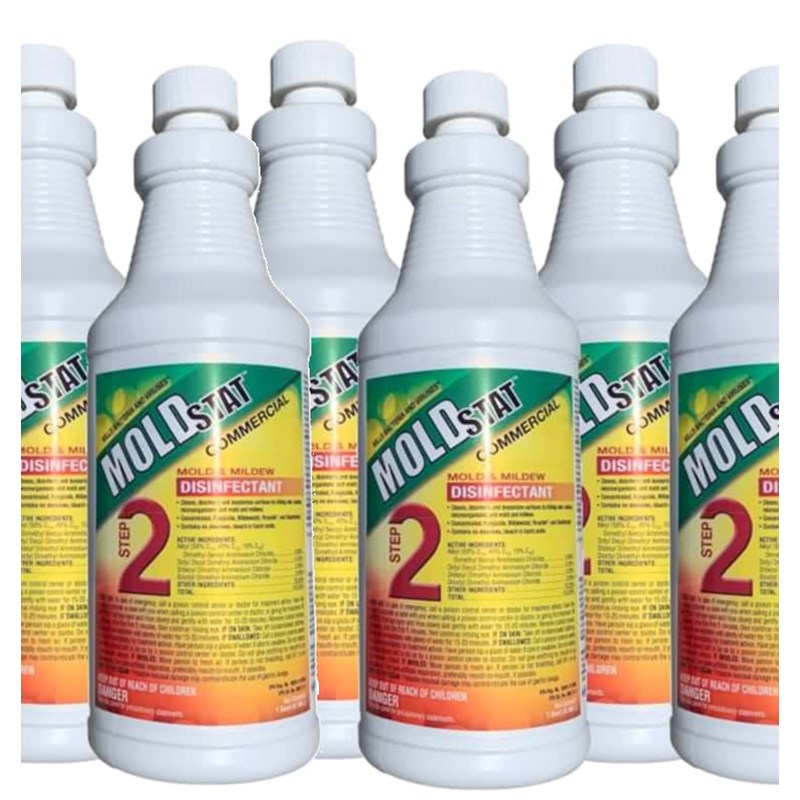Moldstat 2 Commercial Case of 6 Quarts
Quick Overview
- This product is toxic to fish and aquatic invertebrates.
- Cleans, disinfects and deodorizes surfaces by killing odor causing microorganisms and mold and mildew.
- Allow to air dry. Rinsing of floors is not necessary unless they are to be waxed or polished.
- Treated surfaces must remain wet for 10 minutes.
Show More
$80.10
$91.55
Moldstat 2 Disinfectant Cleaner 32oz Concentrate - 6 Quart Case
Moldstat 2 Disinfectant Tech Sheet
Kills Bacteria and Viruses
- Cleans, disinfects and deodorizes surfaces by killing odor causing microorganisms and mold and mildew.
- Concentrated, Fungicide, Mildewstat, Virucide*, and Disinfectant.
- Contains no abrasives, bleach or harsh acids.
- pH 12.0 - 13.0
- Form Liquid - Concentrate
- Fragrance Aromatic
- Color Light Green
- Packaged 1 Quart bottle - 6 quarts to the case
- EPA Reg. No. 10324-72-9367
- Primary EPA Est. No. 9367-FL-1
- Mix Ratio: Virucidal and general Bacterial - 1/2 ounce per Gallon - Yields: 32 Gallons of Spray per pint - 384 Gallons of Spray per Case
- Mix Ration: Athletes Foot ( Candida albicans, Trichophyton mentagrophytes) - 3/4 ounce per gallon
DIRECTIONS FOR USE
(Not for use in CA.)
- Dimethyl Benzyl Ammonium Chloride 8.68%
- Octyl Decyl Dimethyl Ammonium Chloride 6.50%
- Didecyl Dimethyl Ammonium Chloride 3.26%
- Dioctyl Dimethyl Ammonium Chloride 3.26%
- OTHER INGREDIENTS: 78.30%
- TOTAL 100.00%
EMERGENCY RESPONSE NUMBER Provided by ChemTel Inc. 1-800-255-3924
PERFORMANCE:
VIRUCIDAL: This product kills the following viruses in 10 minutes at 0.5 oz. per gallon of water (850 ppm active) in 400 ppm hard water, 5% soil on hard, non-porous surfaces: Avian Influenza A/Turkey/Wisconsin Virus, Avian Influenza A Virus (H5N1), Herpes Simplex Type 1 Virus, Herpes Simplex Type 2 Virus, Human Coronavirus, Influenza A/Brazil Virus, Influenza A Virus (H1N1), Respiratory Syncytial Virus, Vaccinia Virus.
- Pre-clean heavily soiled areas.
- Apply use solution of 0.5 oz. of this product per gal. of water (or equivalent use dilution) to disinfecthard, non-porous surfaces with a sponge, brush, cloth, mop, by immersion, mechanical spray device, coarse pump or trigger spray device. For spray applications, spray 6-8 inches from surface. Do not breathe spray.
- Treated surfaces must remain wet for 10 minutes.
- Allow to air dry. Rinsing of floors is not necessary unless they are to be waxed or polished.
- Prepare a fresh solution daily or when visibly dirty.
Do not mix this product with other cleaning products.
To use as a deodorizer against water damage, extract the excess water. Test hidden area for colorfastness. Dilute 0.5 to 1 oz. of this product per gal. of water, allowing for the diluting effect of absorbed water within saturated materials. Remove gross filth or heavy soil. Apply directly with a mechanical spray device or coarse pump or trigger spray device to fully saturate affected materials. For spray applications, spray 6-8 inches from surface. Do not breathe spray. Roll, brush or agitate into materials. Follow with a thorough extraction. Dry rapidly and thoroughly.
(Not for use in CA)
Corrosive. Causes irreversible eye damage and skin burns. Harmful if swallowed, inhaled or absorbed through the skin. Avoid breathing spray mist. Do not get in eyes, on skin or on clothing. Wear goggles or face shield and rubber gloves and protective clothing when handling. Wash thoroughly with soap and water after handling and before eating, drinking, chewing gum, using tobacco or using the toilet. Remove contaminated clothing and wash clothing before reuse.
CONTAINER HANDLING: Non-Refillable Container. Do not reuse or refill this container. Triple rinse container (or equivalent) promptly after emptying. Triple rinse as follows: Fill the container ¼ full with water and recap. Shake for 10 seconds. Drain for 10 seconds after the flow begins to drip. Follow Pesticide Disposal instructions for rinsate disposal. Repeat this procedure two more times. Then offer for recycling if available or puncture and dispose of in a sanitary landfill, or by incineration.
This product kills the following bacteria in 10 minutes at 0.5 oz. per gallon of water (850 ppm active) in 400 ppm hard water, 5% soil on hard, non-porous surfaces: Burkholderia cepacia, Campylobacter jejuni, Corynebacterium ammoniagenes, Enterobacter aerogenes, Enterobacteriaciae (with extended beta-lactamase resistance), Enterobacter cloacae, Enterococcus faecalis, Enterococcus faecium (Vancomycin Resistant), Escherichia coli, Escherichia coli (Antibiotic resistant), Escherichia coli O157:H7, Klebsiella pneumoniae, Klebsiella pneumoniae (Antibiotic resistant), Legionella pneumophila, Listeria monocytogenes, Proteus mirabilis, Proteus vulgaris, Pseudomonas aeruginosa, Pseudomonas aeruginosa (Antibiotic resistant), Salmonella enterica, Salmonella schottmuelleri, Salmonella typhi, Serratia marcescens, Shigella dysenteriae, Shigella flexneri, Shigella sonnei, Staphylococcus aureus, Staphylococcus aureus (CA MRSA) (Community Acquired Methicillin Resistant), Staphylococcus aureus (Methicillin resistant), Staphylococcus epidermidis (Antibiotic resistant), Streptococcus pyogenes, Vibrio cholerae.
(Not for use in CA.)


Proposition 65 requires businesses to provide warnings to Californians about significant exposures to chemicals that cause cancer, birth defects or other reproductive harm. These chemicals can be in the products that Californians purchase, in their homes or workplaces, or that are released into the environment. By requiring that this information be provided, Proposition 65 enables Californians to make informed decisions about their exposures to these chemicals. Proposition 65 also prohibits California businesses from knowingly discharging significant amounts of listed chemicals into sources of drinking water. Proposition 65 requires California to publish a list of chemicals known to cause cancer, birth defects or other reproductive harm. This list, which must be updated at least once a year, has grown to include approximately 900 chemicals since it was first published in 1987. Proposition 65 became law in November 1986, when California voters approved it by a 63-37 percent margin. The official name of Proposition 65 is the Safe Drinking Water and Toxic Enforcement Act of 1986.
The list of chemicals contains a wide range of naturally occurring and synthetic chemicals that include additives or ingredients in pesticides, common household products, food, drugs, dyes, or solvents. Listed chemicals may also be used in manufacturing and construction, or they may be byproducts of chemical processes, such as motor vehicle exhaust. For more information visit www.p65warnings.ca.gov/






